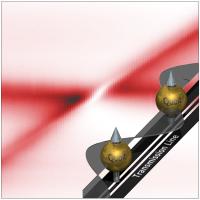Nov 15 2013
An international team of scientists has shown for the first time that atoms can work collectively rather than independently of each other to share light.
 This is an illustration of the artificial atoms or "qubits" alongside the one-dimensional "waveguide" or transmission line. Credit: Photo supplied by Barry Sanders.
This is an illustration of the artificial atoms or "qubits" alongside the one-dimensional "waveguide" or transmission line. Credit: Photo supplied by Barry Sanders.
Quantum physicists have long discussed such an effect, but it has not been seen before in an experiment.
The team included scientists from ETH Zürich (a leading university in Switzerland) who performed the experiment and theoretical scientists from the Université de Sherbrooke in Québec and the University of Calgary in Alberta.
The researchers showed the sharing of light or "photon-mediated interaction" between artificial atoms confined to a one-dimensional quantum system.
Their paper, "Photon-mediated interactions between distant artificial atoms," is published this week in the top-ranked journal Science.
"It's an unobserved effect that has been discussed for decades, and we see it with excellent agreement between theory and experiment," says co-author Barry Sanders, professor of Physics and Astronomy at the U of C and iCORE Chair of Quantum Information Science.
The two artificial atoms "showed a coherent exchange interaction, something not seen before for distant quantum systems in an open environment," says lead author Arjan van Loo, a PhD student in the Quantum Device Lab at ETH Zürich.
Realizing fundamental quantum interactions between individual quantum systems in one dimension is crucial to advance quantum-based devices.
"Systems like ours are expected to be useful for routing quantum information along quantum communication lines (one-dimensional waveguides) on devices used for quantum information processing or quantum communication," says co-author Andreas Wallraff, professor of Solid-State Physics at ETH Zürich.
This research shows that "man-made electrical circuits can now be engineered in such a way to exhibit behaviour that is not possible in 'natural' quantum systems," says co-author Alexandre Blais, associate professor of Physics at Université de Sherbrooke.
Getting artificial atoms to work collectively could lead to control of microwave fields in superconducting circuits with benefits, including ways to protect quantum information against "noise" or damage to the signal, says Sanders, director of the U of C's Institute for Quantum Science and Technology. "I think what we've shown is going to be critical for future applications."
The key to the team's approach was to do the experiment in one dimension rather than in three dimensions where the interaction between atoms is weak and declines significantly with distance.
"In our experiment, we surpassed these limitations by specially engineering the critical properties of our artificial quantum systems," says co-author Arkady Fedorov, a postdoc at ETH Zürich, now at the University of Queensland, Brisbane, Australia, when the experiment was done.
The researchers confined two artificial atoms to one dimension using a waveguide (similar to confining light in an optical fibre), which greatly increased the possibility of the two systems interacting and enabled the researchers to measure this interaction.
Using superconducting circuits, the team was able to put two artificial atoms alongside the waveguide and then send a microwave field through this one-dimensional waveguide.
At a distance of approximately two centimetres – much larger than typically expected for quantum systems – the two atom-like systems formed a type of weakly bound molecule, due to the exchange of photons ('particles' of light).
"We also observed how the superconducting circuits either synchronize to emit radiation much more efficiently displaying superradiance (a very bright source of radiation), or how the circuits trap radiation, turning the two systems dark, as they do not emit photons anymore," Wallraff says.
The Canadian theorists used the "Mammouth" supercomputer, part of a national high-performance computing platform coordinated by Compute Canada, to solve analytical equations, and "also worked a lot with the experimentalists to understand intuitively the physics going on," says co-author Kevin Lalumière, a PhD student in Physics at Université de Sherbrooke.
Press release avilable from http://www.eurekalert.org/